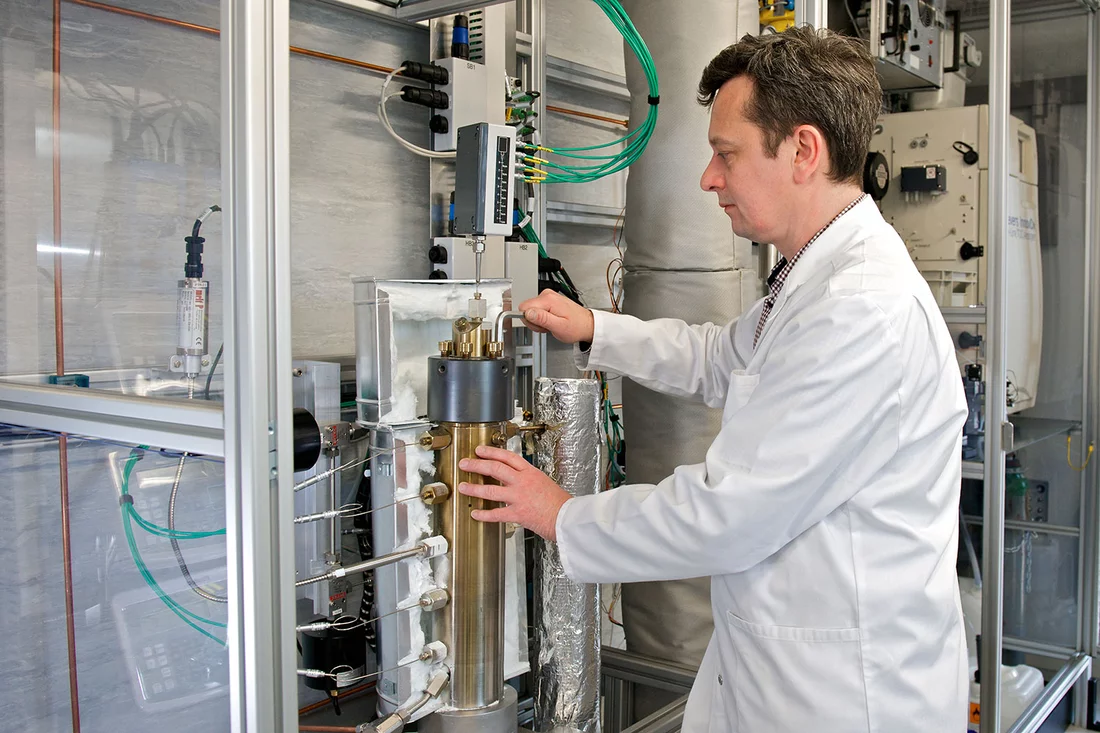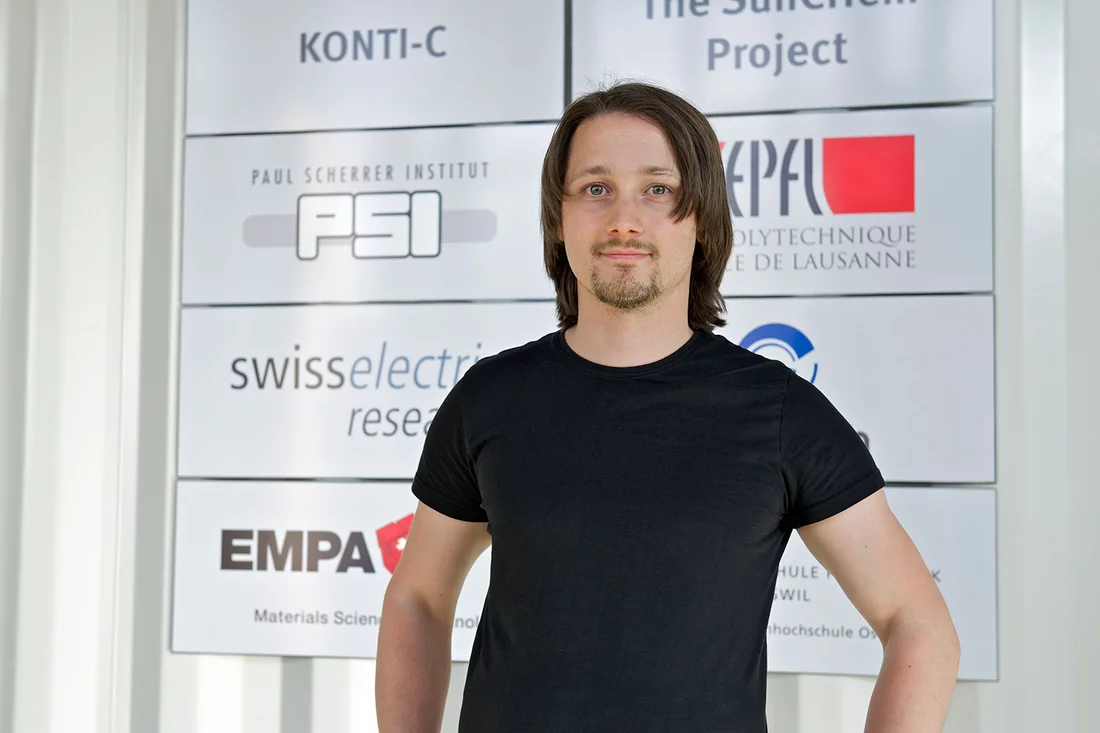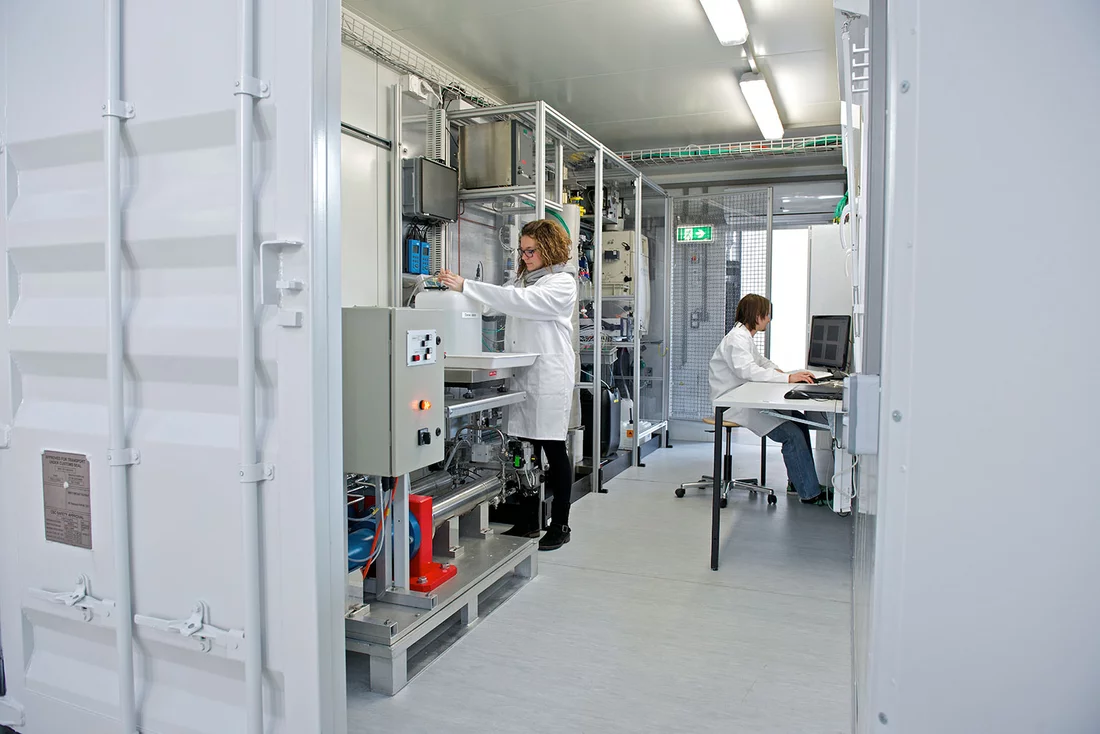On 28 March 2014 the topping-out ceremony for a new test facility to study energy production from wet biomass was celebrated at the Paul Scherrer Institute (PSI). The facility housed in a ship container is supposed to produce synthetic biogas from liquid manure, sewage sludge or algae.
Biomass contains a lot of energy – energy that can be obtained renewably and practically all over the world. For many countries, the use of the energy stored in biomass would thus constitute a major step towards energy independence.
Large parts of the biomass that can be used for energy purposes are available in wet form. And as there has not been an efficient method to convert it into fuel until now, they are lying fallow. In Switzerland, although the sustainable energy potential of wet biomass is estimated at 34.8 petajoules per year, only 10.9 petajoules are actually utilised. Besides the wet biomass already available today, algae also harbour great potential. Although algae grow quickly and can be turned into both energy sources and fine chemicals, however, there is still a lot of research to be conducted into their utilisation. The PSI teamed up with ETH Lausanne, Empa and the Hochschule für Technik Rapperswil on the project SunCHem with the aim of demonstrating the technical and economic feasibility of a method for the production of energy from algae. It is within the scope of this project that the new test facility has now been realised at the PSI.
Biogas from wet biomass
The energy input required to dry biomass is often too high for commercial use. Researchers at the PSI are working on a method to tap into the dormant wealth of energy in wet biomass at lower “energy costs”, i.e. more efficiently.
The method, which generates methane, is referred to as hydrothermal gasification and involves processing the biomass at high temperatures and pressures, which enables the salts contained in the raw material to be separated off more easily thanks to the properties of supercritical water. At high enough temperatures and pressures (374°C, 300 bar), water enters into a so-called supercritical state. Unlike in everyday subcritical water, salts are not water-soluble in this state – a crucial aspect as it enables a nutrient-neutral production of bioenergy from algae or the recycling of valuable nutrients from liquid manure or sewage sludge. This step is also necessary to protect the catalyst used to produce methane.
Moreover, in hydrothermal gasification the energy input used to evaporate the water and dry the biomass is no longer necessary as, in a supercritical state, water is neither liquid nor gaseous, but rather combines properties of both states of matter. This renders the hydrothermal gasification method far more efficient than the biotechnological alternatives. In hydrothermal gasification, 60 to 75 per cent of the energy contained in the source material can be converted into usable energy.
The aim: up to 100 hours of continuous operation
The continuous hydrothermal gasification of algae is now to be demonstrated at the new test facility KONTI-C. The aim is to keep the process running uninterruptedly for up to 100 hours. For this to work, the individual components of the facility need to work flawlessly and all the process parameters be optimally adjusted. However, SunCHem project supervisor Christian Ludwig is confident. After all, the team has already spent a number of years researching the method, albeit only on a small lab scale so far. Two PSI research groups (Catalytic Process Engineering, headed by Frédéric Vogel, and Chemical Processes and Materials under Christian Ludwig) are collaborating on the process development and planning further tests with liquid manure, sewage sludge and other aqueous biomass.
The PSI process consists of the following steps:
- Pumping the biomass slurry at 300 bar
- Heating to approx. 400 °C under pressure
- Separating the nutrient salts in the salt separator at approx. 450 °C
- Gasification into methane in the catalytic methanation reactor at 400-450 °C
- Cooling and separation of water and gas, subsequent depressurisation
- Separating off the CO2 (not implemented at the test facility)
The advantages of hydrothermal gasification at a glance:
- More efficiency
- No drying necessary (water serves as reaction medium)
- Products are pure water and methane
- Efficient use of existing and new kinds of biomass for energy purposes
- Efficient recycling of nutrients
- Hormones and bioactive molecules can be destroyed
Text: Paul Scherrer Institute/Leonid Leiva
Additional information
SunCHem ProjectLaboratory for Bioenergy and Catalysis
Contact
Prof. Dr. Christian Ludwig, Head of Group Chemical processes and materials and SunCHem project leader,Laboratory for Bioenergy and Catalysis, Paul Scherrer Institute,
Telephone: +41 56 310 26 96, E-Mail: christian.ludwig@psi.ch
Prof. Dr. Frédéric Vogel, Head of Group Catalytic Process Engineering,
Laboratory for Bioenergy and Catalysis, Paul Scherrer Institute,
Telephone: +41 56 310 21 35 , E-mail: frederic.vogel@psi.ch



